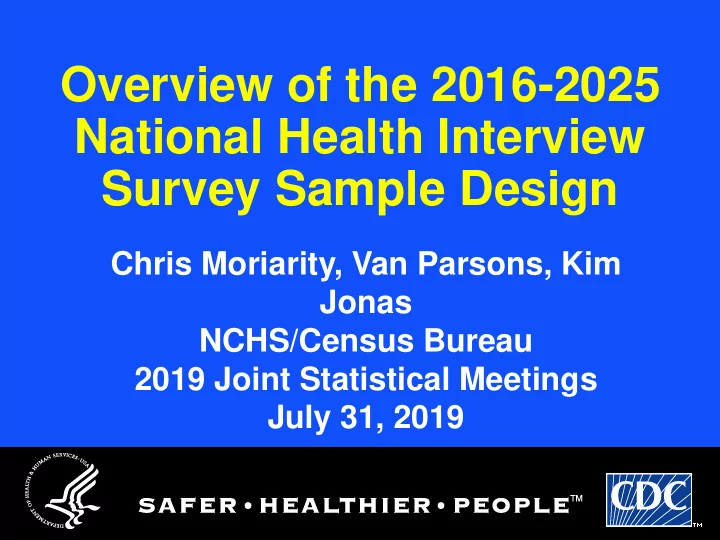

Overview of the 2016-2025 National Health Interview Survey Sample Design Chris Moriarity, Van Parsons, Kim Jonas NCHS/Census Bureau 2019 Joint Statistical Meetings July 31, 2019
Presentation outline National Health Interview Survey (NHIS) overview Major changes implemented in the 2016 sample redesign
NHIS features A major source of official U.S. statistical information about the health of U.S. residents Personal visit interview survey, operating continuously since 1957 Annual sample size as of 2016 if no sample cuts/augmentations: ~87,500 persons in ~35,000 completed household interviews
NHIS sample design periods Each sample design period is ~10 years long, based on information from previous decennial census Most recent completed period: 2006-2015, based on Census 2000 Current: 2016-2025(?), based on 2010 Census
Some historic NHIS sample design features Emphasis on producing precise national estimates - sample allocation by state approximately proportional to state population size Most NHIS sample designs have sampled in all U.S. States and D.C. (an exception: the 1985-1994 design)
2016 NHIS sample redesign: several major changes Build in more flexibility to increase/decrease overall sample and/or shift sample allocations by State from year to year, if desired (lead time required to implement) New source of sample addresses
How did we implement the increased flexibility? Selected a large initial sample, called the "super sample", of groups of addresses Assigned "entry orders" to govern which pieces come in/go out if there is a change in an annual sample size, and/or changes in the distribution of the sample
Super sample selection preparation Independent sampling in each U.S. state and D.C. Geographic areas (one or more contiguous counties) defined to delineate interviewer travel boundaries (personal visit survey) Geographic areas assigned to one or two groups (strata) in each state
Super sample selection In each state/stratum, groups of addresses defined within the geographic areas Selection of a systematic sample of groups of addresses Where the selected address groups were located determined which geographic areas were in the super sample
Different sampling mechanism than previous NHIS sample designs Previously, the geographic areas were primary sampling units (PSU) First, a sample of PSUs would be selected, then a sample of address groups would be selected within the sampled PSUs
Previous sampling mechanism inhibits flexibility We discovered in the previous NHIS sample design period that having a fixed sample of PSUs was not optimal if funding was provided for large-scale sample augmentation More efficient sample augmentation possible with current sampling mechanism
NHIS sample address source, 1985-2015 Sample addresses for the 1985-94, 1995-2005, and 2006-2015 NHIS sample designs came primarily from field listing The Census Bureau can share NHIS sample addresses with NCHS NCHS uses the addresses for other surveys, record linkage, etc.
2016 NHIS sample design: change in sample address source Other demographic surveys conducted by the Census Bureau moved toward using the Master Address File (MAF) as the main source of sample addresses NCHS had been sharing costs for NHIS field listing; NCHS could not afford the full cost of listing
2016 NHIS sample design address source: address list NCHS did not want to use MAF addresses for NHIS because MAF addresses are confidential, they cannot be shared NHIS now using a commercial address list (from MSG) as main sample address source, beginning in 2016
Issues to address when using a commercial address list Accuracy, geocoding quality, coverage of areas like college dormitories, etc. How to do periodic updates How to select annual samples that do not overlap with previous ones
2013-4 MSG list research by the Census Bureau Coverage: MAF record linkage results allowed NCHS/Census to make more informed decisions about where to use the MSG list No-stat addresses/filtering: Census's research showed that inclusion of some "no-stat" addresses provided better coverage, and guided development of filtering algorithm for inclusion
Working with the commercial address list Geocoding: Census Bureau doing independent geocoding Periodic updates come from vendor; sample of "new growth" selected annually MSG list used in areas identified by Census Bureau's research; independent listing elsewhere
Summary The NHIS undergoes periodic sample redesigns, generally at an interval of about every 10 years Current NHIS sample design has two major changes included: increased flexibility, new main source of sample addresses
Recommend
More recommend